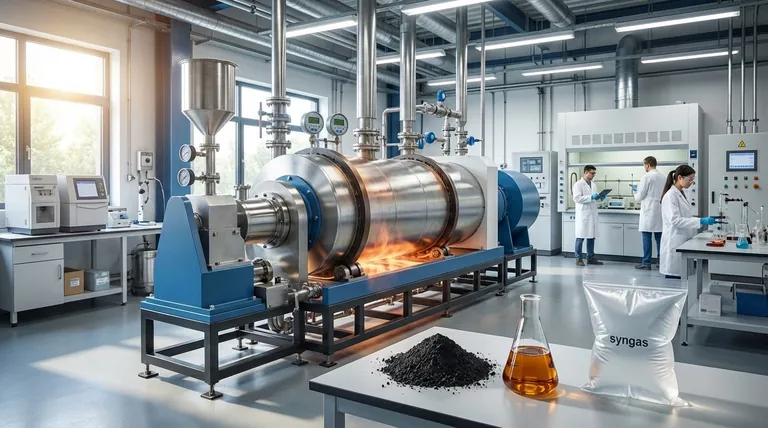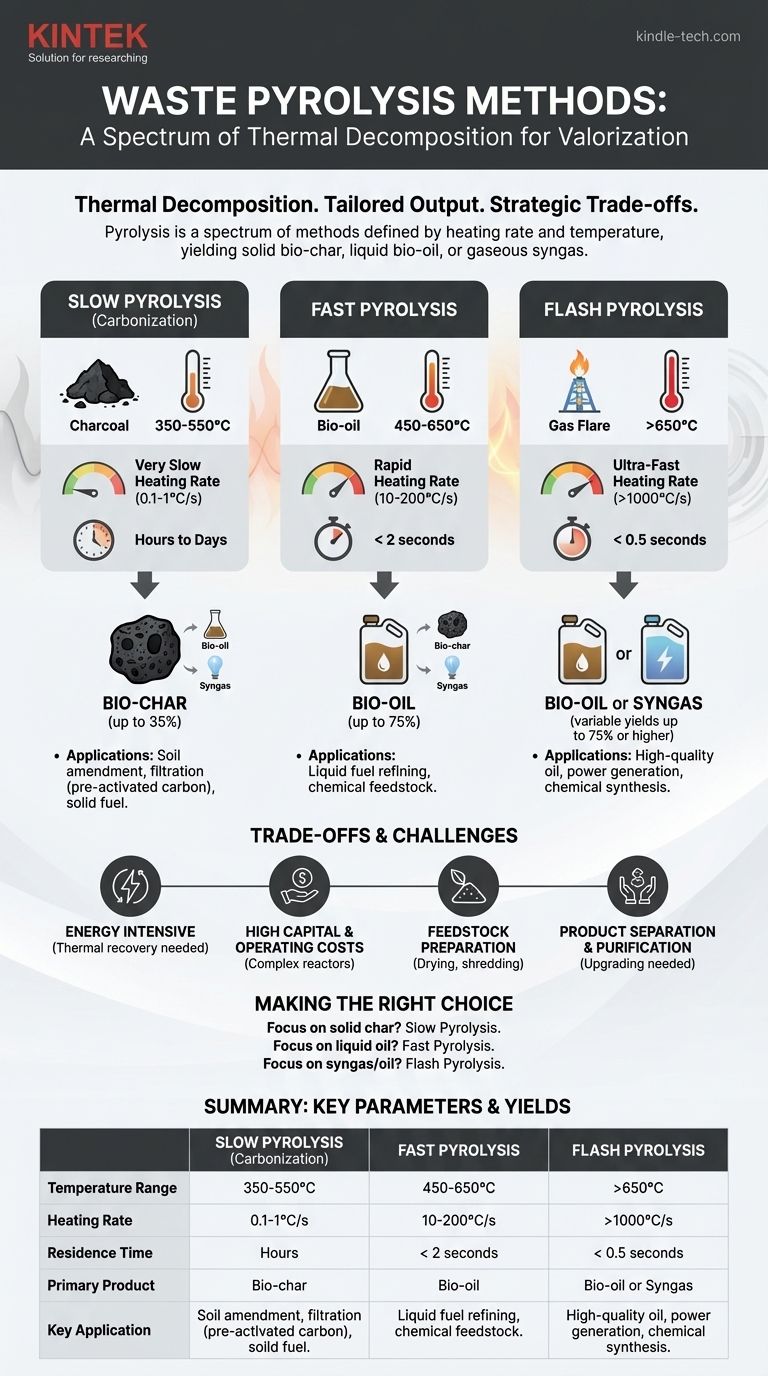In essence, pyrolysis is not a single process but a spectrum of thermal decomposition methods. The specific method is defined by its heating rate and operating temperature, which in turn dictates whether the primary output is a solid (bio-char), a liquid (bio-oil), or a gas (syngas).
The core decision in selecting a pyrolysis method is a strategic trade-off. You must balance the desired product—solid char, liquid oil, or gas—against the required process speed, temperature, and complexity.

The Three Primary Pyrolysis Methods
Pyrolysis of waste is categorized into three main types based on the heating rate and the time the material spends in the reactor, known as the residence time. Each method is optimized to yield a different primary product.
Slow Pyrolysis (Carbonization)
This is the traditional method, often used for producing charcoal. It involves heating the waste material slowly over a long period.
- Key Parameters: It uses low temperatures (around 350-550°C) and very slow heating rates (0.1-1°C per second). The residence time is long, lasting from hours to days.
- Primary Product Yields: This process is optimized to maximize the solid product, bio-char, which can make up around 35% of the output by weight. Bio-oil and syngas are produced in smaller, roughly equal amounts.
- Common Applications: Primarily used for creating bio-char for soil amendment, filtration (as a precursor to activated carbon), or as a solid fuel.
Fast Pyrolysis
This method is engineered to maximize the liquid product, bio-oil. It is the most common approach for waste-to-liquid fuel applications.
- Key Parameters: Fast pyrolysis uses moderate to high temperatures (450-650°C) with a very rapid heating rate (10-200°C per second). The residence time is extremely short, typically less than 2 seconds.
- Primary Product Yields: This process can yield up to 75% bio-oil by weight, with smaller amounts of bio-char (around 15%) and syngas (around 10%).
- Common Applications: Ideal for converting biomass and plastics into bio-oil, which can be refined into transportation fuels or used as a heating oil or chemical feedstock.
Flash Pyrolysis
Flash pyrolysis represents the most extreme conditions, aiming for either very high bio-oil yields or increased gas production. It requires more advanced and precisely controlled reactors.
- Key Parameters: This method uses high temperatures (often above 650°C) and ultra-fast heating rates (over 1000°C per second). The residence time is even shorter than fast pyrolysis, often less than 0.5 seconds.
- Primary Product Yields: It can further increase the bio-oil yield (up to 75%) or, at higher temperatures, be tuned to favor the production of syngas. Bio-char production is minimized.
- Common Applications: Used in specialized applications to produce high-quality oils or to maximize the output of syngas, which can be used for electricity generation or synthesizing chemicals like methanol.
Understanding the Trade-offs and Challenges
While pyrolysis is a promising technology for waste valorization, it is not a silver bullet. A clear-eyed assessment of its challenges is critical for any project's success.
Energy Consumption
The process is energy-intensive. A significant amount of thermal energy is required to bring the feedstock to the target temperature. An efficient system must be able to recover and reuse heat, often by burning some of the syngas produced.
High Capital and Operating Costs
Pyrolysis reactors, especially for fast and flash methods, represent a substantial capital investment. The need for precise temperature control, material handling, and product collection systems contributes to high upfront and ongoing operational costs.
Feedstock Preparation
The efficiency of pyrolysis is highly dependent on the feedstock quality. Waste must often be dried, shredded, and sorted to ensure uniform particle size and low moisture content, adding complexity and cost to the overall process.
Product Separation and Purification
The raw outputs—char, oil, and gas—are not immediately usable. They exist as a mixed stream that requires efficient separation. Furthermore, bio-oil is often acidic, unstable, and contains water and solids, requiring significant upgrading before it can be used as a drop-in fuel.
Making the Right Choice for Your Goal
Your selection of a pyrolysis method must be driven by your end-product objective and your tolerance for process complexity.
- If your primary focus is solid bio-char production for agriculture or filtration: Slow pyrolysis is the most direct and technologically simplest path.
- If your primary focus is maximizing liquid bio-oil from biomass or plastics: Fast pyrolysis offers the best balance of high yield and established technology.
- If your primary focus is producing syngas for power generation or chemical synthesis: Flash pyrolysis at higher temperatures is the most effective method.
Ultimately, the optimal pyrolysis strategy aligns the specific waste stream with the most valuable end product and the available technical and financial resources.
Summary Table:
| Method | Temperature Range | Heating Rate | Residence Time | Primary Product | Key Application |
|---|---|---|---|---|---|
| Slow Pyrolysis | 350-550°C | 0.1-1°C/s | Hours to Days | Bio-char (up to 35%) | Soil amendment, filtration, solid fuel |
| Fast Pyrolysis | 450-650°C | 10-200°C/s | < 2 seconds | Bio-oil (up to 75%) | Liquid fuel, chemical feedstock |
| Flash Pyrolysis | >650°C | >1000°C/s | < 0.5 seconds | Bio-oil or Syngas | High-quality oil, power generation, chemicals |
Ready to select the right pyrolysis method for your waste valorization project? KINTEK specializes in providing robust lab equipment and consumables for pyrolysis research and development. Our experts can help you choose the right technology to optimize your process for bio-char, bio-oil, or syngas production. Contact our team today to discuss your specific laboratory needs and discover how KINTEK can support your success.
Visual Guide

Related Products
- Electric Rotary Kiln Small Rotary Furnace Biomass Pyrolysis Plant
- Vacuum Sealed Continuous Working Rotary Tube Furnace Rotating Tube Furnace
- Electric Rotary Kiln Continuous Working Small Rotary Furnace Heating Pyrolysis Plant
- Laboratory Quartz Tube Furnace Tubular RTP Heating Furnace
- Customizable High Pressure Reactors for Advanced Scientific and Industrial Applications
People Also Ask
- What are the products of pyrolysis of biomass? Unlock Bio-Char, Bio-Oil, and Syngas
- What are the components of biomass pyrolysis? A Complete Guide to the System, Products, and Process
- How is energy converted into biomass? Harnessing Nature's Solar Power for Renewable Energy
- What are the conditions for biomass pyrolysis? Optimize Temperature, Heating Rate & Time
- Is pyrolysis viable? A Guide to Economic, Technological, and Environmental Success



















